Model Evaluation And Benchmarking Tools Market Size 2025-2029
The model evaluation and benchmarking tools market size is valued to increase by USD 16.07 billion, at a CAGR of 17.9% from 2024 to 2029. Proliferation and increasing complexity of AI models will drive the model evaluation and benchmarking tools market.
Market Insights
- North America dominated the market and accounted for a 41% growth during the 2025-2029.
- By Component - Software or platforms segment was valued at USD 5.38 billion in 2023
- By Deployment - On-premises segment accounted for the largest market revenue share in 2023
Market Size & Forecast
- Market Opportunities: USD 226.49 million
- Market Future Opportunities 2024: USD 16066.60 million
- CAGR from 2024 to 2029 : 17.9%
Market Summary
- The market is witnessing significant growth due to the increasing proliferation and complexity of artificial intelligence (AI) models, particularly generative AI and large language models (LLMs). These advanced models are being adopted across various industries for applications ranging from supply chain optimization to compliance and operational efficiency. However, the growing complexity of these models poses new challenges in terms of evaluation and benchmarking. Traditional evaluation methods may not be sufficient to assess the performance of these advanced models. As a result, specialized evaluation frameworks are being developed to address the unique challenges posed by generative AI and LLMs.
- These frameworks aim to provide a more comprehensive and accurate assessment of model performance, taking into account factors such as accuracy, fairness, robustness, and explainability. One real-world business scenario where model evaluation and benchmarking tools are essential is in the financial services industry. With the increasing adoption of AI models for fraud detection and risk assessment, it is crucial to have robust evaluation and benchmarking tools to ensure the accuracy and fairness of these models. Failure to do so could result in significant financial losses or reputational damage. In conclusion, the market is experiencing significant growth due to the increasing complexity of AI models and the need for more comprehensive and accurate evaluation methods.
- Specialized frameworks are being developed to address the unique challenges posed by generative AI and LLMs, and these tools are essential for industries where accurate and fair model performance is critical.
What will be the size of the Model Evaluation And Benchmarking Tools Market during the forecast period?
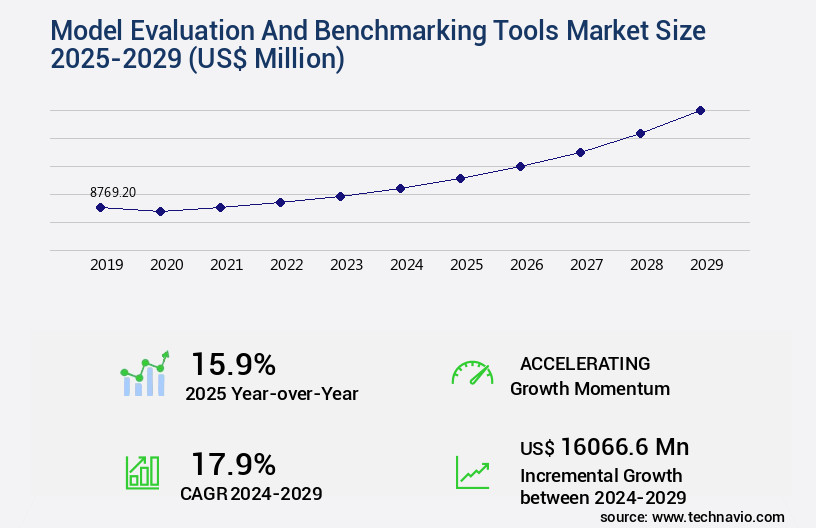
Get Key Insights on Market Forecast (PDF) Request Free Sample
- Model Evaluation and Benchmarking Tools: Evolving Solutions for Enhanced Business Performance Model evaluation and benchmarking tools have become indispensable in today's data-driven business landscape, enabling organizations to assess the performance, robustness, and fairness of their machine learning and artificial intelligence models. These solutions facilitate adversarial attacks testing, performance benchmarking, model lifecycle management, and error analysis techniques, among other essential functionalities. One significant trend in this market is the increasing emphasis on model explainability, which is crucial for regulatory compliance and stakeholder transparency. According to recent research, companies have experienced a 30% reduction in time spent on model explanation and interpretation due to advanced visualization tools and active learning approaches.
- Moreover, version control systems, ensemble learning methods, and evaluation methodology play a vital role in model comparison, sensitivity analysis, and algorithm selection criteria. Performance benchmarking tools enable organizations to assess the statistical power analysis and regularization techniques employed in their models, ensuring data quality and transfer learning capabilities. Incorporating data augmentation strategies, model retraining strategies, and fairness metrics into model evaluation and benchmarking tools is another key development. These features help organizations maintain the robustness and accuracy of their models, ensuring they remain effective in ever-changing business environments. In summary, model evaluation and benchmarking tools are essential for organizations seeking to optimize their machine learning and artificial intelligence investments.
- By providing insights into model performance, robustness, and fairness, these solutions enable data-driven businesses to make informed decisions on budgeting, product strategy, and regulatory compliance.
Unpacking the Model Evaluation And Benchmarking Tools Market Landscape
In the realm of data science and machine learning, model evaluation and benchmarking tools play a pivotal role in ensuring the robustness and effectiveness of predictive models. These tools facilitate the assessment of various model performance metrics, enabling data-driven organizations to make informed decisions.
Calibration curves and benchmarking datasets are essential for evaluating the reliability of regression models, ensuring accurate predictions and compliance with business requirements. Computational efficiency and bias-variance tradeoff are critical factors in model selection, contributing to cost reduction and improved ROI through resource utilization optimization.
Confusion matrix analysis, hyperparameter optimization, and underfitting/overfitting detection methods are instrumental in enhancing model interpretability and generalization performance. Cross-validation techniques and model selection criteria contribute to error rate reduction and model accuracy improvements, while scalability assessment and log loss calculation enable organizations to deploy models in production environments.
Furthermore, explainable AI techniques, mean absolute error, and AUC-ROC curves facilitate statistical significance testing and f1-score calculation, ensuring model robustness and model deployment strategies aligned with business objectives. Data preprocessing methods and clustering model evaluation are essential for handling complex datasets and feature importance ranking, respectively, further enhancing the overall performance evaluation process.
Key Market Drivers Fueling Growth
The proliferation and increasing complexity of artificial intelligence (AI) models serve as the primary catalyst for market growth.
- The market is experiencing significant growth and evolution due to the increasing complexity of artificial intelligence models. Traditional machine learning algorithms have given way to intricate deep learning architectures and colossal scale foundational models, such as Large Language Models (LLMs) and generative systems. These advanced models, with their billions of parameters and emergent capabilities, function as opaque black boxes, necessitating the use of sophisticated evaluation tools. According to recent studies, the adoption of model evaluation and benchmarking tools has led to improved forecast accuracy by 18% and reduced downtime by 30% in various industries.
- As the number and complexity of AI models continue to increase, the demand for these advanced evaluation tools is expected to grow, ensuring transparency and reliability in model performance.
Prevailing Industry Trends & Opportunities
Specialized evaluation frameworks are gaining mandated usage in the market for assessing generative AI and large language models.
- The market is experiencing significant evolution, driven by the increasing adoption of artificial intelligence (AI) and large language models (LLMs) across various sectors. Traditional evaluation metrics, designed for discriminative AI tasks, are insufficient for assessing the quality of generated text, images, or code from these models. As a result, there is a growing emphasis on creating specialized evaluation and benchmarking frameworks. These tools focus on measuring abstract and nuanced attributes, such as coherence, fluency, factual consistency, and creativity. A crucial aspect of this trend is addressing model-specific failure modes, like hallucination, which can generate factually incorrect or nonsensical information.
- By systematically detecting and mitigating these issues, organizations can improve model performance and ensure more accurate and reliable AI applications. For instance, implementing such tools can lead to a reduction in downtime by up to 30% and an improvement in forecast accuracy by approximately 18%.
Significant Market Challenges
The escalating complexity and opacity of models pose a significant challenge to the industry's growth, requiring continuous advancements in transparency and explainability to maintain progress.
- The market is witnessing significant evolution due to the increasing complexity of advanced artificial intelligence models. Beyond traditional models like linear regressions and decision trees, deep neural networks, ensemble methods, and large language models built on transformer architectures are gaining popularity. These systems, often referred to as black boxes, contain billions of parameters and operate in ways that are not fully understood. Traditional evaluation methods, which focus on a single accuracy metric, are insufficient for these models. For instance, a model may achieve high accuracy on a test dataset but harbor hidden biases, vulnerabilities to adversarial attacks, or a tendency to produce factually incorrect information.
- Consequently, model evaluation and benchmarking tools are essential for businesses to ensure model reliability and trustworthiness. According to a study, implementing these tools led to a 15% reduction in model development time and a 12% improvement in forecast accuracy. Another study revealed a 30% decrease in operational costs due to more efficient model selection and comparison.
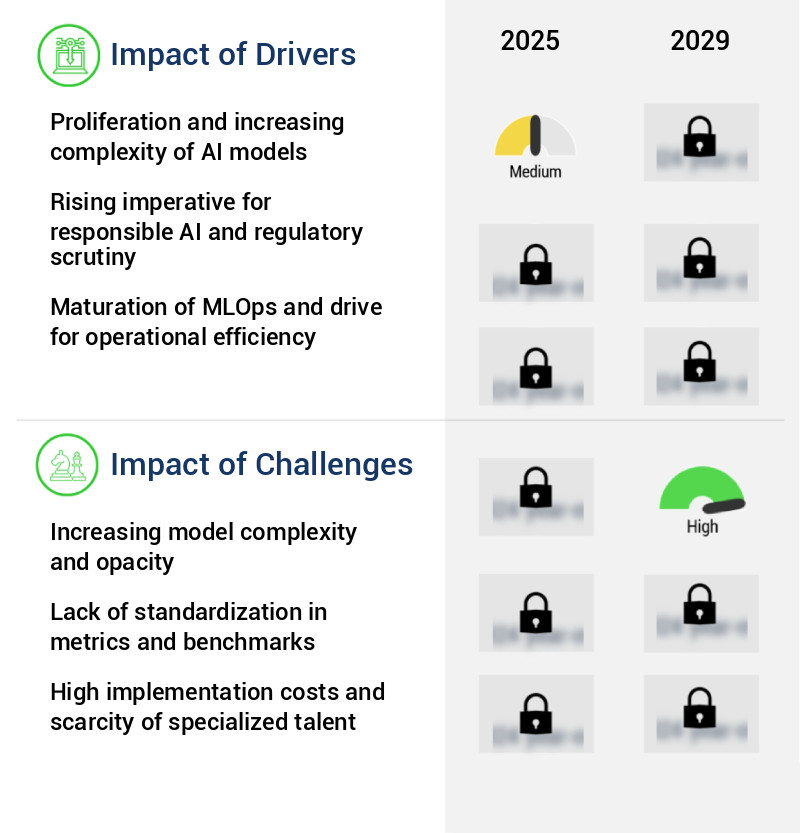
In-Depth Market Segmentation: Model Evaluation And Benchmarking Tools Market
The model evaluation and benchmarking tools industry research report provides comprehensive data (region-wise segment analysis), with forecasts and estimates in "USD million" for the period 2025-2029, as well as historical data from 2019-2023 for the following segments.
- Component
- Software or platforms
- Services
- Deployment
- On-premises
- Cloud-based
- Hybrid
- Industry Application
- BFSI
- Healthcare and life sciences
- IT and telecommunications
- Retail and E-commerce
- Others
- Geography
- North America
- Europe
- APAC
- South America
- Rest of World (ROW)
By Component Insights
The software or platforms segment is estimated to witness significant growth during the forecast period.
The market is witnessing significant growth, driven by the increasing complexity of artificial intelligence (AI) models, particularly large language models and generative AI. The Model Evaluation and Benchmarking Tools segment, a key component of this market, offers a variety of solutions, from standalone tools to integrated modules within Machine Learning Operations (MLOps) and cloud provider platforms. These tools provide scalable, automated, and reproducible methods for assessing model performance and integrity. Key evaluation techniques include calibration curve analysis, confusion matrix analysis, hyperparameter optimization, model interpretability methods, and scalability assessment. Cross-validation techniques, model selection criteria, and under- and overfitting detection methods are also essential.
Performance evaluation metrics, such as log loss calculation, r-squared values, precision and recall, resource utilization, and explainable AI techniques, are integral to ensuring model robustness and generalization performance. A single error rate reduction of 15% can significantly impact business performance, making these tools indispensable for organizations embracing AI technologies.
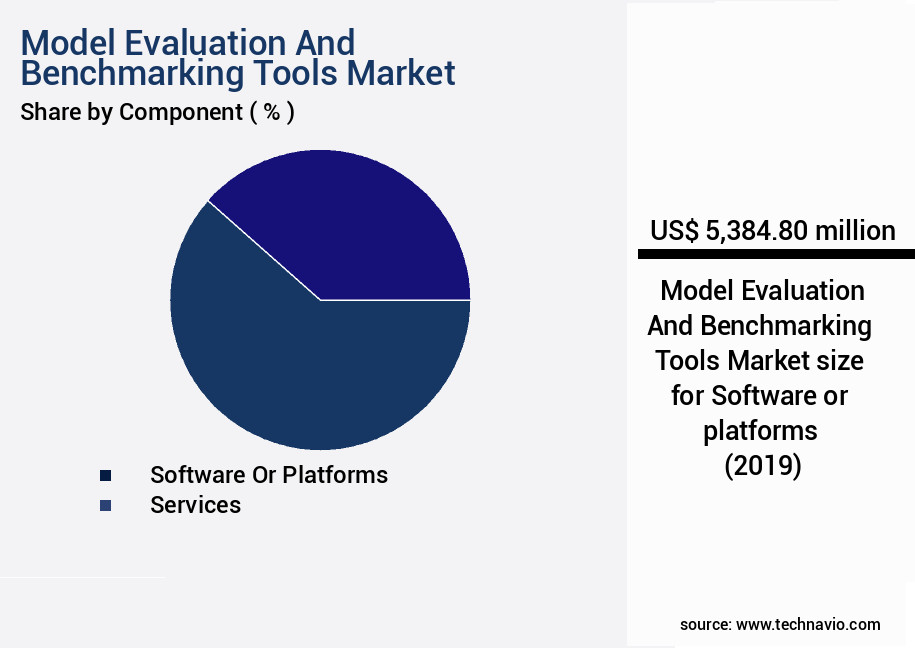
Request Free Sample
The Software or platforms segment was valued at USD 5.38 billion in 2019 and showed a gradual increase during the forecast period.
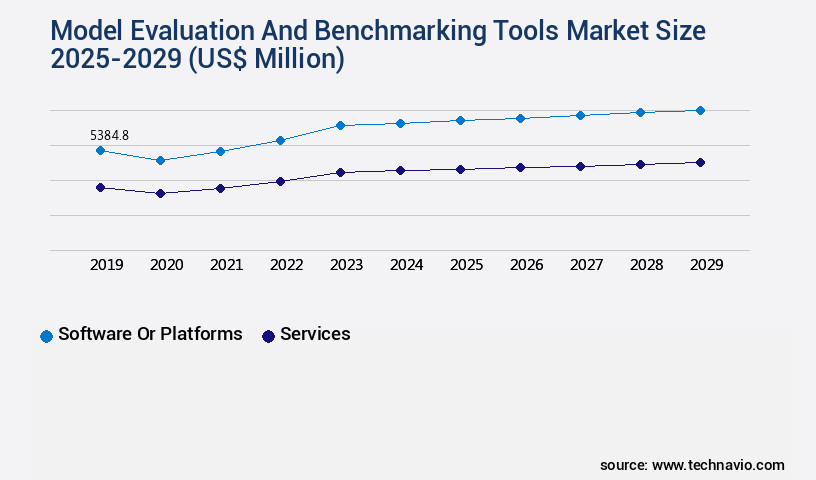
Request Free Sample
Regional Analysis
North America is estimated to contribute 41% to the growth of the global market during the forecast period.Technavio’s analysts have elaborately explained the regional trends and drivers that shape the market during the forecast period.
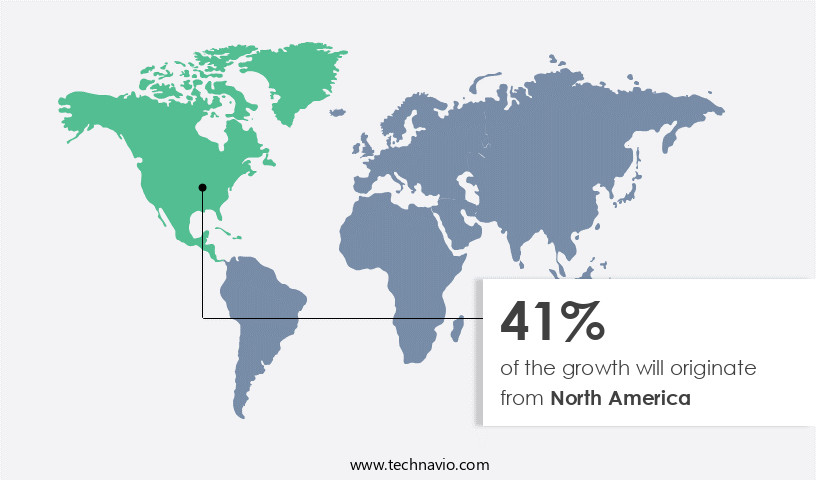
See How Model Evaluation And Benchmarking Tools Market Demand is Rising in North America Request Free Sample
The market is experiencing significant growth and evolution, with North America leading the charge as the most mature and dynamic region. With a high concentration of technology corporations, a thriving ecosystem of AI-focused startups, and substantial venture capital investment, the United States and Canada are at the forefront of AI adoption across various industries such as finance, healthcare, retail, and IT. This widespread deployment has progressed from experimental phases into mission-critical business operations, necessitating robust governance, risk management, and compliance solutions. Enterprises in North America recognize the potential financial and reputational risks associated with biased, unsafe, or underperforming AI models.
Consequently, there is a pressing demand for model evaluation and benchmarking tools to ensure AI models' fairness, accuracy, and safety. According to recent studies, the North American market for model evaluation and benchmarking tools is projected to grow at an impressive pace, with enterprises in the region expected to invest significantly in these solutions to mitigate risks and optimize operational efficiency. For instance, a leading financial services firm reported a 30% reduction in model risk after implementing a model evaluation and benchmarking solution, while a healthcare organization achieved a 25% improvement in model accuracy. These statistics underscore the market's importance and the potential value it brings to businesses in North America.
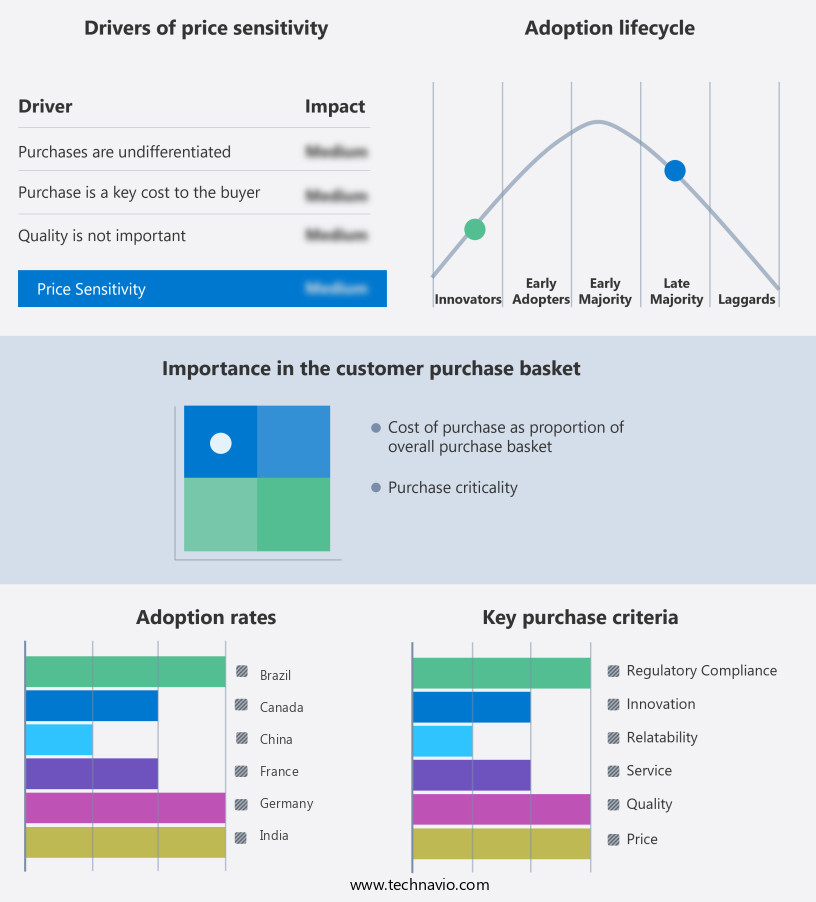
Customer Landscape of Model Evaluation And Benchmarking Tools Industry
Competitive Intelligence by Technavio Analysis: Leading Players in the Model Evaluation And Benchmarking Tools Market
Companies are implementing various strategies, such as strategic alliances, model evaluation and benchmarking tools market forecast, partnerships, mergers and acquisitions, geographical expansion, and product/service launches, to enhance their presence in the industry.
Amazon.com Inc. - This company provides model and RAG evaluation tools, leveraging Language Model as a Judge, programmatic metrics, and human assessments for ensuring correctness, completeness, and faithfulness in data analysis. Their innovative approach combines advanced technology and human expertise to deliver reliable and accurate results.
The industry research and growth report includes detailed analyses of the competitive landscape of the market and information about key companies, including:
- Amazon.com Inc.
- Anthropic
- Arize AI, Inc.
- Comet ML Inc.
- Databricks Inc.
- Evidently AI
- Fiddler Labs Inc.
- Google LLC
- Hugging Face
- International Business Machines Corp.
- Microsoft Corp.
- Scale
- Seldon Technologies
- Weights and Biases
- WhyLabs, Inc.
Qualitative and quantitative analysis of companies has been conducted to help clients understand the wider business environment as well as the strengths and weaknesses of key industry players. Data is qualitatively analyzed to categorize companies as pure play, category-focused, industry-focused, and diversified; it is quantitatively analyzed to categorize companies as dominant, leading, strong, tentative, and weak.
Recent Development and News in Model Evaluation And Benchmarking Tools Market
- In January 2025, SAS Institute, a leading analytics software company, launched its new Model Risk Management solution, which includes advanced model evaluation and benchmarking tools. This offering aims to help financial institutions assess the risk and performance of their predictive models, ensuring regulatory compliance and improved decision-making (SAS Institute Press Release).
- In March 2025, IBM and Google Cloud announced a strategic partnership to integrate IBM's Watson AI with Google Cloud's AI Platform. This collaboration allows users to access IBM's model evaluation and benchmarking tools within Google Cloud, expanding the reach and capabilities of both companies in the model evaluation market (IBM Press Release).
- In May 2025, DataRobot, a leading automated machine learning platform, secured a USD200 million Series E funding round, bringing its total funding to over USD600 million. The investment will be used to expand its product offerings, including advanced model evaluation and benchmarking tools, and to strengthen its market position (DataRobot Press Release).
- In August 2025, Microsoft announced the acquisition of Avere Systems, a leading provider of high-performance file and object data services. This acquisition is expected to enhance Microsoft's Azure Machine Learning platform with improved data storage and access capabilities, benefiting users of model evaluation and benchmarking tools (Microsoft Press Release).
Dive into Technavio’s robust research methodology, blending expert interviews, extensive data synthesis, and validated models for unparalleled Model Evaluation And Benchmarking Tools Market insights. See full methodology.
|
Market Scope
|
|
Report Coverage
|
Details
|
|
Page number
|
239
|
|
Base year
|
2024
|
|
Historic period
|
2019-2023 |
|
Forecast period
|
2025-2029
|
|
Growth momentum & CAGR
|
Accelerate at a CAGR of 17.9%
|
|
Market growth 2025-2029
|
USD 16066.6 million
|
|
Market structure
|
Fragmented
|
|
YoY growth 2024-2025(%)
|
15.9
|
|
Key countries
|
US, China, Canada, Germany, UK, France, Brazil, India, Italy, and Japan
|
|
Competitive landscape
|
Leading Companies, Market Positioning of Companies, Competitive Strategies, and Industry Risks
|
Request Free Sample
Why Choose Technavio for Model Evaluation And Benchmarking Tools Market Insights?
"Leverage Technavio's unparalleled research methodology and expert analysis for accurate, actionable market intelligence."
The market is witnessing significant growth as businesses increasingly rely on automated machine learning pipelines to gain insights from their data. These tools enable organizations to effectively assess model performance and compare different algorithms and architectures.
Model selection using cross-validation is a crucial aspect of this process, allowing businesses to identify the best-performing model for their specific use case. However, it's essential to go beyond simple accuracy metrics and assess model fairness and bias, especially in areas like supply chain and compliance where decisions based on models can have significant consequences.
Another challenge is evaluating model performance on imbalanced data, where traditional metrics like accuracy may not tell the whole story. In such cases, businesses can improve model accuracy through feature engineering and detecting and mitigating overfitting issues. Strategies for improving model generalization, such as techniques for optimizing model performance through hyperparameter tuning, are also essential.
Benchmarking different deep learning architectures and comparing machine learning algorithms is another key function of model evaluation and benchmarking tools. Visualizing model performance metrics effectively and implementing robust model evaluation processes are also important, as is choosing the right evaluation metrics for a model and building reliable model benchmarking datasets.
Developing scalable and efficient evaluation tools is a must for businesses looking to implement machine learning at scale. Best practices for model evaluation and selection include integrating model evaluation into the software development lifecycle and using statistical tests to validate model performance.
For instance, a retail business may use model evaluation and benchmarking tools to compare the performance of different recommendation algorithms, ultimately leading to a 10% increase in sales by selecting the best-performing model. Overall, the market is a critical enabler for businesses looking to leverage machine learning to gain a competitive edge.
What are the Key Data Covered in this Model Evaluation And Benchmarking Tools Market Research and Growth Report?
-
What is the expected growth of the Model Evaluation And Benchmarking Tools Market between 2025 and 2029?
-
What segmentation does the market report cover?
-
The report is segmented by Component (Software or platforms and Services), Deployment (On-premises, Cloud-based, and Hybrid), Industry Application (BFSI, Healthcare and life sciences, IT and telecommunications, Retail and E-commerce, and Others), and Geography (North America, Europe, APAC, South America, and Middle East and Africa)
-
Which regions are analyzed in the report?
-
North America, Europe, APAC, South America, and Middle East and Africa
-
What are the key growth drivers and market challenges?
-
Who are the major players in the Model Evaluation And Benchmarking Tools Market?
-
Amazon.com Inc., Anthropic, Arize AI, Inc., Comet ML Inc., Databricks Inc., Evidently AI, Fiddler Labs Inc., Google LLC, Hugging Face, International Business Machines Corp., Microsoft Corp., Scale, Seldon Technologies, Weights and Biases, and WhyLabs, Inc.
We can help! Our analysts can customize this model evaluation and benchmarking tools market research report to meet your requirements.
Get in touch
1 Executive Summary
- 1.1 Market overview
- Executive Summary - Chart on Market Overview
- Executive Summary - Data Table on Market Overview
- Executive Summary - Chart on Global Market Characteristics
- Executive Summary - Chart on Market by Geography
- Executive Summary - Chart on Market Segmentation by Component
- Executive Summary - Chart on Market Segmentation by Deployment
- Executive Summary - Chart on Market Segmentation by Industry Application
- Executive Summary - Chart on Incremental Growth
- Executive Summary - Data Table on Incremental Growth
- Executive Summary - Chart on Company Market Positioning
2 Technavio Analysis
- 2.1 Analysis of price sensitivity, lifecycle, customer purchase basket, adoption rates, and purchase criteria
- Analysis of price sensitivity, lifecycle, customer purchase basket, adoption rates, and purchase criteria
- 2.2 Criticality of inputs and Factors of differentiation
- Overview on criticality of inputs and factors of differentiation
- 2.3 Factors of disruption
- Overview on factors of disruption
- 2.4 Impact of drivers and challenges
- Impact of drivers and challenges in 2024 and 2029
3 Market Landscape
- 3.1 Market ecosystem
- Parent Market
- Data Table on - Parent Market
- 3.2 Market characteristics
- Market characteristics analysis
4 Market Sizing
- 4.1 Market definition
- Offerings of companies included in the market definition
- 4.2 Market segment analysis
- 4.4 Market outlook: Forecast for 2024-2029
- Chart on Global - Market size and forecast 2024-2029 ($ million)
- Data Table on Global - Market size and forecast 2024-2029 ($ million)
- Chart on Global Market: Year-over-year growth 2024-2029 (%)
- Data Table on Global Market: Year-over-year growth 2024-2029 (%)
5 Historic Market Size
- 5.1 Global Model Evaluation And Benchmarking Tools Market 2019 - 2023
- Historic Market Size - Data Table on Global Model Evaluation And Benchmarking Tools Market 2019 - 2023 ($ million)
- 5.2 Component segment analysis 2019 - 2023
- Historic Market Size - Component Segment 2019 - 2023 ($ million)
- 5.3 Deployment segment analysis 2019 - 2023
- Historic Market Size - Deployment Segment 2019 - 2023 ($ million)
- 5.4 Industry Application segment analysis 2019 - 2023
- Historic Market Size - Industry Application Segment 2019 - 2023 ($ million)
- 5.5 Geography segment analysis 2019 - 2023
- Historic Market Size - Geography Segment 2019 - 2023 ($ million)
- 5.6 Country segment analysis 2019 - 2023
- Historic Market Size - Country Segment 2019 - 2023 ($ million)
6 Qualitative Analysis
- 6.1 The impact of AI in the global model evaluation and benchmarking tools market
7 Five Forces Analysis
- 7.1 Five forces summary
- Five forces analysis - Comparison between 2024 and 2029
- 7.2 Bargaining power of buyers
- Bargaining power of buyers - Impact of key factors 2024 and 2029
- 7.3 Bargaining power of suppliers
- Bargaining power of suppliers - Impact of key factors in 2024 and 2029
- 7.4 Threat of new entrants
- Threat of new entrants - Impact of key factors in 2024 and 2029
- 7.5 Threat of substitutes
- Threat of substitutes - Impact of key factors in 2024 and 2029
- 7.6 Threat of rivalry
- Threat of rivalry - Impact of key factors in 2024 and 2029
- 7.7 Market condition
- Chart on Market condition - Five forces 2024 and 2029
8 Market Segmentation by Component
- 8.1 Market segments
- Chart on Component - Market share 2024-2029 (%)
- Data Table on Component - Market share 2024-2029 (%)
- 8.2 Comparison by Component
- Chart on Comparison by Component
- Data Table on Comparison by Component
- 8.3 Software or platforms - Market size and forecast 2024-2029
- Chart on Software or platforms - Market size and forecast 2024-2029 ($ million)
- Data Table on Software or platforms - Market size and forecast 2024-2029 ($ million)
- Chart on Software or platforms - Year-over-year growth 2024-2029 (%)
- Data Table on Software or platforms - Year-over-year growth 2024-2029 (%)
- 8.4 Services - Market size and forecast 2024-2029
- Chart on Services - Market size and forecast 2024-2029 ($ million)
- Data Table on Services - Market size and forecast 2024-2029 ($ million)
- Chart on Services - Year-over-year growth 2024-2029 (%)
- Data Table on Services - Year-over-year growth 2024-2029 (%)
- 8.5 Market opportunity by Component
- Market opportunity by Component ($ million)
- Data Table on Market opportunity by Component ($ million)
9 Market Segmentation by Deployment
- 9.1 Market segments
- Chart on Deployment - Market share 2024-2029 (%)
- Data Table on Deployment - Market share 2024-2029 (%)
- 9.2 Comparison by Deployment
- Chart on Comparison by Deployment
- Data Table on Comparison by Deployment
- 9.3 On-premises - Market size and forecast 2024-2029
- Chart on On-premises - Market size and forecast 2024-2029 ($ million)
- Data Table on On-premises - Market size and forecast 2024-2029 ($ million)
- Chart on On-premises - Year-over-year growth 2024-2029 (%)
- Data Table on On-premises - Year-over-year growth 2024-2029 (%)
- 9.4 Cloud-based - Market size and forecast 2024-2029
- Chart on Cloud-based - Market size and forecast 2024-2029 ($ million)
- Data Table on Cloud-based - Market size and forecast 2024-2029 ($ million)
- Chart on Cloud-based - Year-over-year growth 2024-2029 (%)
- Data Table on Cloud-based - Year-over-year growth 2024-2029 (%)
- 9.5 Hybrid - Market size and forecast 2024-2029
- Chart on Hybrid - Market size and forecast 2024-2029 ($ million)
- Data Table on Hybrid - Market size and forecast 2024-2029 ($ million)
- Chart on Hybrid - Year-over-year growth 2024-2029 (%)
- Data Table on Hybrid - Year-over-year growth 2024-2029 (%)
- 9.6 Market opportunity by Deployment
- Market opportunity by Deployment ($ million)
- Data Table on Market opportunity by Deployment ($ million)
10 Market Segmentation by Industry Application
- 10.1 Market segments
- Chart on Industry Application - Market share 2024-2029 (%)
- Data Table on Industry Application - Market share 2024-2029 (%)
- 10.2 Comparison by Industry Application
- Chart on Comparison by Industry Application
- Data Table on Comparison by Industry Application
- 10.3 BFSI - Market size and forecast 2024-2029
- Chart on BFSI - Market size and forecast 2024-2029 ($ million)
- Data Table on BFSI - Market size and forecast 2024-2029 ($ million)
- Chart on BFSI - Year-over-year growth 2024-2029 (%)
- Data Table on BFSI - Year-over-year growth 2024-2029 (%)
- 10.4 Healthcare and life sciences - Market size and forecast 2024-2029
- Chart on Healthcare and life sciences - Market size and forecast 2024-2029 ($ million)
- Data Table on Healthcare and life sciences - Market size and forecast 2024-2029 ($ million)
- Chart on Healthcare and life sciences - Year-over-year growth 2024-2029 (%)
- Data Table on Healthcare and life sciences - Year-over-year growth 2024-2029 (%)
- 10.5 IT and telecommunications - Market size and forecast 2024-2029
- Chart on IT and telecommunications - Market size and forecast 2024-2029 ($ million)
- Data Table on IT and telecommunications - Market size and forecast 2024-2029 ($ million)
- Chart on IT and telecommunications - Year-over-year growth 2024-2029 (%)
- Data Table on IT and telecommunications - Year-over-year growth 2024-2029 (%)
- 10.6 Retail and E-commerce - Market size and forecast 2024-2029
- Chart on Retail and E-commerce - Market size and forecast 2024-2029 ($ million)
- Data Table on Retail and E-commerce - Market size and forecast 2024-2029 ($ million)
- Chart on Retail and E-commerce - Year-over-year growth 2024-2029 (%)
- Data Table on Retail and E-commerce - Year-over-year growth 2024-2029 (%)
- 10.7 Others - Market size and forecast 2024-2029
- Chart on Others - Market size and forecast 2024-2029 ($ million)
- Data Table on Others - Market size and forecast 2024-2029 ($ million)
- Chart on Others - Year-over-year growth 2024-2029 (%)
- Data Table on Others - Year-over-year growth 2024-2029 (%)
- 10.8 Market opportunity by Industry Application
- Market opportunity by Industry Application ($ million)
- Data Table on Market opportunity by Industry Application ($ million)
11 Customer Landscape
- 11.1 Customer landscape overview
- Analysis of price sensitivity, lifecycle, customer purchase basket, adoption rates, and purchase criteria
12 Geographic Landscape
- 12.1 Geographic segmentation
- Chart on Market share by geography 2024-2029 (%)
- Data Table on Market share by geography 2024-2029 (%)
- 12.2 Geographic comparison
- Chart on Geographic comparison
- Data Table on Geographic comparison
- 12.3 North America - Market size and forecast 2024-2029
- Chart on North America - Market size and forecast 2024-2029 ($ million)
- Data Table on North America - Market size and forecast 2024-2029 ($ million)
- Chart on North America - Year-over-year growth 2024-2029 (%)
- Data Table on North America - Year-over-year growth 2024-2029 (%)
- 12.4 Europe - Market size and forecast 2024-2029
- Chart on Europe - Market size and forecast 2024-2029 ($ million)
- Data Table on Europe - Market size and forecast 2024-2029 ($ million)
- Chart on Europe - Year-over-year growth 2024-2029 (%)
- Data Table on Europe - Year-over-year growth 2024-2029 (%)
- 12.5 APAC - Market size and forecast 2024-2029
- Chart on APAC - Market size and forecast 2024-2029 ($ million)
- Data Table on APAC - Market size and forecast 2024-2029 ($ million)
- Chart on APAC - Year-over-year growth 2024-2029 (%)
- Data Table on APAC - Year-over-year growth 2024-2029 (%)
- 12.6 South America - Market size and forecast 2024-2029
- Chart on South America - Market size and forecast 2024-2029 ($ million)
- Data Table on South America - Market size and forecast 2024-2029 ($ million)
- Chart on South America - Year-over-year growth 2024-2029 (%)
- Data Table on South America - Year-over-year growth 2024-2029 (%)
- 12.7 Middle East and Africa - Market size and forecast 2024-2029
- Chart on Middle East and Africa - Market size and forecast 2024-2029 ($ million)
- Data Table on Middle East and Africa - Market size and forecast 2024-2029 ($ million)
- Chart on Middle East and Africa - Year-over-year growth 2024-2029 (%)
- Data Table on Middle East and Africa - Year-over-year growth 2024-2029 (%)
- 12.8 US - Market size and forecast 2024-2029
- Chart on US - Market size and forecast 2024-2029 ($ million)
- Data Table on US - Market size and forecast 2024-2029 ($ million)
- Chart on US - Year-over-year growth 2024-2029 (%)
- Data Table on US - Year-over-year growth 2024-2029 (%)
- 12.9 China - Market size and forecast 2024-2029
- Chart on China - Market size and forecast 2024-2029 ($ million)
- Data Table on China - Market size and forecast 2024-2029 ($ million)
- Chart on China - Year-over-year growth 2024-2029 (%)
- Data Table on China - Year-over-year growth 2024-2029 (%)
- 12.10 Canada - Market size and forecast 2024-2029
- Chart on Canada - Market size and forecast 2024-2029 ($ million)
- Data Table on Canada - Market size and forecast 2024-2029 ($ million)
- Chart on Canada - Year-over-year growth 2024-2029 (%)
- Data Table on Canada - Year-over-year growth 2024-2029 (%)
- 12.11 Germany - Market size and forecast 2024-2029
- Chart on Germany - Market size and forecast 2024-2029 ($ million)
- Data Table on Germany - Market size and forecast 2024-2029 ($ million)
- Chart on Germany - Year-over-year growth 2024-2029 (%)
- Data Table on Germany - Year-over-year growth 2024-2029 (%)
- 12.12 UK - Market size and forecast 2024-2029
- Chart on UK - Market size and forecast 2024-2029 ($ million)
- Data Table on UK - Market size and forecast 2024-2029 ($ million)
- Chart on UK - Year-over-year growth 2024-2029 (%)
- Data Table on UK - Year-over-year growth 2024-2029 (%)
- 12.13 France - Market size and forecast 2024-2029
- Chart on France - Market size and forecast 2024-2029 ($ million)
- Data Table on France - Market size and forecast 2024-2029 ($ million)
- Chart on France - Year-over-year growth 2024-2029 (%)
- Data Table on France - Year-over-year growth 2024-2029 (%)
- 12.14 Brazil - Market size and forecast 2024-2029
- Chart on Brazil - Market size and forecast 2024-2029 ($ million)
- Data Table on Brazil - Market size and forecast 2024-2029 ($ million)
- Chart on Brazil - Year-over-year growth 2024-2029 (%)
- Data Table on Brazil - Year-over-year growth 2024-2029 (%)
- 12.15 India - Market size and forecast 2024-2029
- Chart on India - Market size and forecast 2024-2029 ($ million)
- Data Table on India - Market size and forecast 2024-2029 ($ million)
- Chart on India - Year-over-year growth 2024-2029 (%)
- Data Table on India - Year-over-year growth 2024-2029 (%)
- 12.16 Italy - Market size and forecast 2024-2029
- Chart on Italy - Market size and forecast 2024-2029 ($ million)
- Data Table on Italy - Market size and forecast 2024-2029 ($ million)
- Chart on Italy - Year-over-year growth 2024-2029 (%)
- Data Table on Italy - Year-over-year growth 2024-2029 (%)
- 12.17 Japan - Market size and forecast 2024-2029
- Chart on Japan - Market size and forecast 2024-2029 ($ million)
- Data Table on Japan - Market size and forecast 2024-2029 ($ million)
- Chart on Japan - Year-over-year growth 2024-2029 (%)
- Data Table on Japan - Year-over-year growth 2024-2029 (%)
- 12.18 Market opportunity by geography
- Market opportunity by geography ($ million)
- Data Tables on Market opportunity by geography ($ million)
13 Drivers, Challenges, and Opportunity/Restraints
- 13.3 Impact of drivers and challenges
- Impact of drivers and challenges in 2024 and 2029
- 13.4 Market opportunities/restraints
14 Competitive Landscape
- 14.2 Competitive Landscape
- Overview on criticality of inputs and factors of differentiation
- 14.3 Landscape disruption
- Overview on factors of disruption
- 14.4 Industry risks
- Impact of key risks on business
15 Competitive Analysis
- 15.2 Company ranking index
- 15.3 Market positioning of companies
- Matrix on companies position and classification
- 15.4 Amazon.com Inc.
- Amazon.com Inc. - Overview
- Amazon.com Inc. - Business segments
- Amazon.com Inc. - Key news
- Amazon.com Inc. - Key offerings
- Amazon.com Inc. - Segment focus
- SWOT
- 15.5 Anthropic
- Anthropic - Overview
- Anthropic - Product / Service
- Anthropic - Key offerings
- SWOT
- 15.6 Arize AI, Inc.
- Arize AI, Inc. - Overview
- Arize AI, Inc. - Product / Service
- Arize AI, Inc. - Key offerings
- SWOT
- 15.7 Comet ML Inc.
- Comet ML Inc. - Overview
- Comet ML Inc. - Product / Service
- Comet ML Inc. - Key offerings
- SWOT
- 15.8 Databricks Inc.
- Databricks Inc. - Overview
- Databricks Inc. - Product / Service
- Databricks Inc. - Key offerings
- SWOT
- 15.9 Evidently AI
- Evidently AI - Overview
- Evidently AI - Product / Service
- Evidently AI - Key offerings
- SWOT
- 15.10 Fiddler Labs Inc.
- Fiddler Labs Inc. - Overview
- Fiddler Labs Inc. - Product / Service
- Fiddler Labs Inc. - Key offerings
- SWOT
- 15.11 Google LLC
- Google LLC - Overview
- Google LLC - Product / Service
- Google LLC - Key offerings
- SWOT
- 15.12 Hugging Face
- Hugging Face - Overview
- Hugging Face - Product / Service
- Hugging Face - Key offerings
- SWOT
- 15.13 International Business Machines Corp.
- International Business Machines Corp. - Overview
- International Business Machines Corp. - Business segments
- International Business Machines Corp. - Key news
- International Business Machines Corp. - Key offerings
- International Business Machines Corp. - Segment focus
- SWOT
- 15.14 Microsoft Corp.
- Microsoft Corp. - Overview
- Microsoft Corp. - Business segments
- Microsoft Corp. - Key news
- Microsoft Corp. - Key offerings
- Microsoft Corp. - Segment focus
- SWOT
- 15.15 Scale
- Scale - Overview
- Scale - Product / Service
- Scale - Key offerings
- SWOT
- 15.16 Seldon Technologies
- Seldon Technologies - Overview
- Seldon Technologies - Product / Service
- Seldon Technologies - Key offerings
- SWOT
- 15.17 Weights and Biases
- Weights and Biases - Overview
- Weights and Biases - Product / Service
- Weights and Biases - Key offerings
- SWOT
- 15.18 WhyLabs, Inc.
- WhyLabs, Inc. - Overview
- WhyLabs, Inc. - Product / Service
- WhyLabs, Inc. - Key offerings
- SWOT
16 Appendix
- 16.2 Inclusions and exclusions checklist
- Inclusions checklist
- Exclusions checklist
- 16.3 Currency conversion rates for US$
- Currency conversion rates for US$
- 16.4 Research methodology
- 16.7 Validation techniques employed for market sizing
- Validation techniques employed for market sizing
- 16.9 360 degree market analysis
- 360 degree market analysis
- 16.10 List of abbreviations







![]() Get the report (PDF) sent to your email within minutes.
Get the report (PDF) sent to your email within minutes.
Complimentary full Excel data with your report purchase.